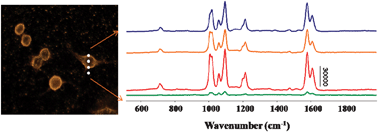Antibody-conjugated gold nanorods (GNRs) have been used for the targeting and imaging of specific cancer markers expressed on the surface membrane of cancer cells. GNRs with various aspect ratios were fabricated, and their surface-enhanced Raman scattering enhancement effects were evaluated. To attach the GNRs selectively onto the targets in cancer cells, specific antibodies were immobilized on the surface of GNRs using the layer-by-layer deposition method. First, Raman reporter molecules, mercaptopyridine, were attached to the surface of GNRs, and their surface charge was modified using poly(sodium 4-styrene-sulfonate) to make the surface charge negative. Then, anti-rabbit IgGs were immobilized onto the surface of the GNRs by electrostatic interactions. HER2 markers, expressed on the cell surface, were treated with anti-HER2 primary antibodies. Finally, the functionalized nanoprobes, conjugated with secondary antibodies, were attached to the markers on cancer cells by antibody–antibody interactions. In the present study, MCF7 cells overexpressing breast cancer marker HER2 were used as the optical imaging targets. Our experimental results demonstrate the potential feasibility of antibody-conjugated GNRs for the highly sensitive targeting and imaging of biomarkers expressed on the surface membrane of cancer cells.

You have access to this article
 Please wait while we load your content...
Something went wrong. Try again?
Please wait while we load your content...
Something went wrong. Try again?


 Please wait while we load your content...
Please wait while we load your content...